Update for August, 2017: This is turning into quite a warm little summer, especially if you’re one of my Oregon readers where temps have already hit triple digits. Up here near Seattle it’s been pleasant bordering on hot, with temps hovering around 75 to 85 for most of July. (Yes, there are about 5 weeks in Seattle when the weather is perfect. But the rest of the year it rains. You’d hate it. Don’t move here.)
I expect these mostly warm, rainless days to continue in August. Expect more of the same. Ripening will continue, tomatoes and peppers and eggplants will do well. Do make sure you keep your garden properly watered – I don’t think a drop of rain fell in my garden last month.
Sometime around mid August something about the angle of the sun, or the speed at which the days shorten, or the smell of the air will change, and if you let the deep part of your squirrel brain alert you, you will know that summer has just signed her deed over to fall. She’ll have a while yet before she actually moves out, but ownership will have been transferred.
From that point on, the clock is ticking. All our lovely, lush summer crops and all our long, lazy nights are but dead men walking. You might start to feel an urgency, the gut feeling that it’s time to hurry and put more jars of tomatoes or peaches in the basement. Or you might feel a strange twinge of sadness as you hover over your pole beans and see pre-echoes of their inevitable decline in the overflowing harvesting basket at your side.
When this realization hits you – that, despite the 85 degree sun shining down on your shoulders, fall has won and is marching towards you in quick-step – it’s best to celebrate by picking something from the garden and eating it.
Savor the moment, as they say. It won’t last for long.
Printable At-A-Glance Grow-Guide!
If you like your Gardening To Lists simple and direct, you’re in luck! Just click the image below to download the August At-A-Glance Grow Guide as a printable PDF.
Or, continue reading below for the full details on everything to do in your garden this month.
Plan and Purchase

Garlic should be ordered now for planting in late September/early October. Don’t wait too long – they do sell out. I like hardneck varieties, which don’t store quite as well as braidable softnecks, but give you one layer of much larger cloves. Music is my favorite.
If you have a minute, this is a good time to plan for any perennial purchases, too. Fruit trees and bushes that go in the ground in late fall have an entire winter to settle in before spring growth. Raintree is a great local nursery for well-adapted fruits. They have the classics like apples and raspberries and plums, and also stock weird stuff like honeyberry, aronia and goji.
August is when the bulk of the harvest of beans, squash, tomatoes and the like comes on . In between canning and pickling, think about what you have enough of, what you are overwhelmed by, and what you really wish you had more of. Write this info down, along with how much of each thing you are currently growing. That info will come in handy when you plan next year’s garden.
Start Indoors/In A Pot
My seed-starting lights are off until next spring. It’s too late to start long-maturing cabbage, broccoli, cauliflower, brussels sprouts, etc. (though good nurseries will have appropriate season starts in now to purchase if you need.)
Fast maturing greens like lettuce and spinach, and the Asian coles like pak choi can be started now, but it’s easier at this time of year to direct seed.
Sow Directly Outside
- Salad greens – August is a great month to direct sow fall greens. Sow lettuces and any of the fall greens like arugula, mache, or spinach at any time this month. Be diligent about watering the emerging seedlings. In general it’s better to water deep and less often, but until baby plants get some root under them and have a few true leaves, plan on at least a daily sprinkle.
- Euro greens – Sow your sophisticated bitter greens like frisee, escarole, radicchio and endive now too. They taste best when they mature in the cool days of September.
- Kale – Sow now and your plants won’t be big going into winter, but they’ll give you something to pick from. I’d sow relatively thickly and plan on eating the thinnings.
- Chard – same as kale. If you so now, plan for teenage size plants and space accordingly. If fall is particularly mild and sunny, just pull out and eat every other plant as you need the room.
- Radishes – gotta love anything that can be ready to pick from seeding in 3 or 4 weeks. Radishes sown towards the mid/end of August will mature as the days are cooling off and will hold in the ground as tasty mild radishes for quite awhile. If you are sowing the winter hardy varieties like Black Spanish or Daikon-style radishes, those take a lot longer to mature and should go in ASAP.
- Green Onions: I’m always surprised how long green onions take to mature, but a sowing now should give you some in fall. If they go in late, you’ll have a very early spring scallion crop.
- Asian Brassicas: early August is a great time to seed all kinds of fast maturing Asian brassicas: Chinese cabbage, bok choy, Chinese mustard greens, mizuna, tatsoi, etc. My nursery carries seed from Kitazawa Seed, a specialty Asian vegetable seed company, and the variety of Asian greens is pretty amazing. Check it out.
- Root crops: hopefully you’ve already seeded beets, carrots, parsnips, rutabagas and turnips. If you haven’t and you have room, it can’t hurt to throw some seed down and see what you get. Even if a late sowing doesn’t give you much of a fall harvest, if your root crops overwinter, you may get a nice, very early spring crop.
- Legumes: sow out your fall peas and favas this month.
Transplant Out
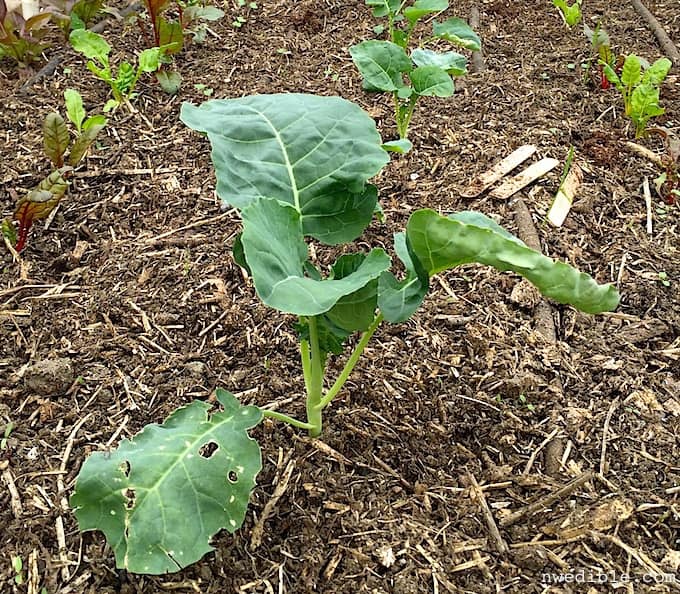
Ok, here’s the big job: get those transplants you started in late June and early July in the ground as soon as possible. Hopefully they are 4-6 weeks old now, nicely filling out their pots, but not rootbound.
Remember to water your transplants! If it’s hot and sunny, cover them with shade cloth or prop a cardboard box lid up on wooden posts over them to protect them from too hard of sun after the transplant. If you didn’t start seedlings last month or in June, your local nursery may be carrying starts to purchase.
- Broccoli and Sprouting Broccoli
- Brussels Sprouts
- Cabbage
- Cauliflower
- Chinese Cabbage
- Collards
- Green Onions
- Kale
- Kohlrabi
- Leeks
- Lettuce
- Mustard Greens
- Swiss Chard
Harvest
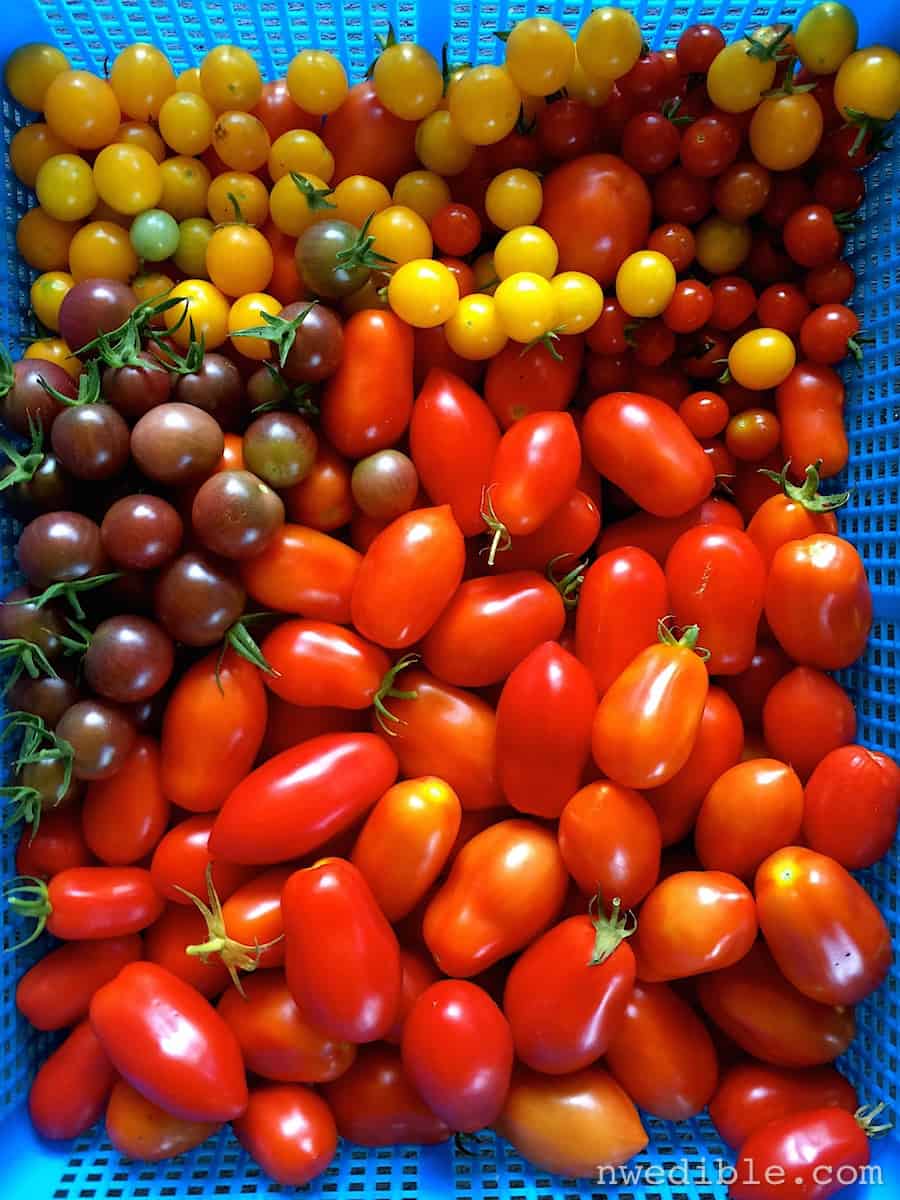
Pretty much everything except the fall root crops, winter squash and some of the fall/winter brassicas (for me, brussels sprouts are fall/winter only) are ready. August is A-to-Z prime time in the garden.
Vegetables
- Artichokes
- Beans
- Beets
- Broccoli
- Cabbage
- Carrots
- Chard
- Corn
- Cucumber
- Eggplant
- Kale
- Onions
- Peas – you may have another few weeks on peas, depending on what variety you planted, but August is typically when they collapse and the vines go brown and crispy.
- Peppers
- Potatoes – summer new potatoes! A lovely thing!
- Salad greens
- Tomatoes
- Zucchini and other summer squash
Fruit
- Strawberries – everbearing types are still chunking along.
- Blueberries
- Raspberries
- Blackberries
- Marionberries
- Currants
- Cherries – wrapping up now.
- Apple – the earliest apples should start maturing in late August. A few of my apples are already tasting decent. Still tart but no longer puckeringly astringent.
- Pear & Asian Pear – just like apples – look for the earliest varieties to be ready soon.
- Asian plums – as of 2017 my huge harvest is happening late July/early August
- European plums – the earliest will be ready this month, my main crop will come on in early September
- Peaches
- Nectarines
- Apricots
Maintenance

August is always when I most feel torn between maintaining the outside stuff, bringing it all inside to preserve, and just saying “screw this, I’m going to the beach.”
If you have a large garden, just keeping up on the picking, eating, and preserving can seem like an unending task right now. If you can, try to just do a little bit every day.
- Weed, water, mulch. Repeat, repeat, repeat. Pay extra close attention to the water needs of anything fruiting (cucumbers, beans, peppers, etc.), plus any transplants and seedlings coming up for the fall and winter garden.
- Harvest, pick, gather. Repeat, repeat, repeat. Try to eat your garden goodness fresh when you can!
- Pickle, freeze, ferment, can. Repeat, repeat, repeat. What you can’t eat fresh, preserve for leaner months.
- Cure onions – Depending on variety you might be curing onions this month. Knock down onion tops when most fall over on their own, then dry in a breezy place out of direct sun.
- Pinch out climbing beans – if you don’t want your beans to be a big mass of tangles, pinch their growing tips out when they hit the top of their supports. I never do this.
- Train tomatoes – I train my indeterminate tomatoes to single or double cordons around twine. This keeps them in line and manageable, but it does require that I regularly pinch out the sideshoots that want to grow out. (Related: How I train and prune indeterminate tomatoes – Patreon)
- Train cucumbers – You can get fancy and pinch out side growth, or pinch out main growth, or pinch off growth two leaves past the fruit. I don’t know, I just shove mine back into the trellis and periodically cut off any huge leaves that are shading the plant, or chop some unfruitful parts of the vine off if they get way, way out of control. (Related: Building A Cucumber Trellis – Patreon)
- Side dress heavy feeders – Do this if you notice your plant growth slowing or leaf color lightening. Anything that is working hard for you over a long time should be fed. I side dressed everything in my garden with a balanced organic fertilizer about a week ago. Super leafy things (think spinach or basil) that like higher nitrogen can get the occasional fertigation with fish emulsion or, if you’re up for it, diluted pee. (Related: How to Use Pee In Your Garden and Gravity Fed Pee Fertigation System – Patreon.)
- Net ripening fruit against birds if that’s a problem for you. Or get cats. I have decided bird netting is spun from filaments of hatred, bound together with evil. I’ll take my chances with the birds.
- Summer prune soft fruit and espaliered/heavily-managed tree fruit.
- Tie in canefruit as necessary.
- Trap or apply Sluggo regularly for slug and snail control if necessary.
- Handpick or apply BT for cabbage moth control if necessary.
How’s this month of insane harvesting going for you?
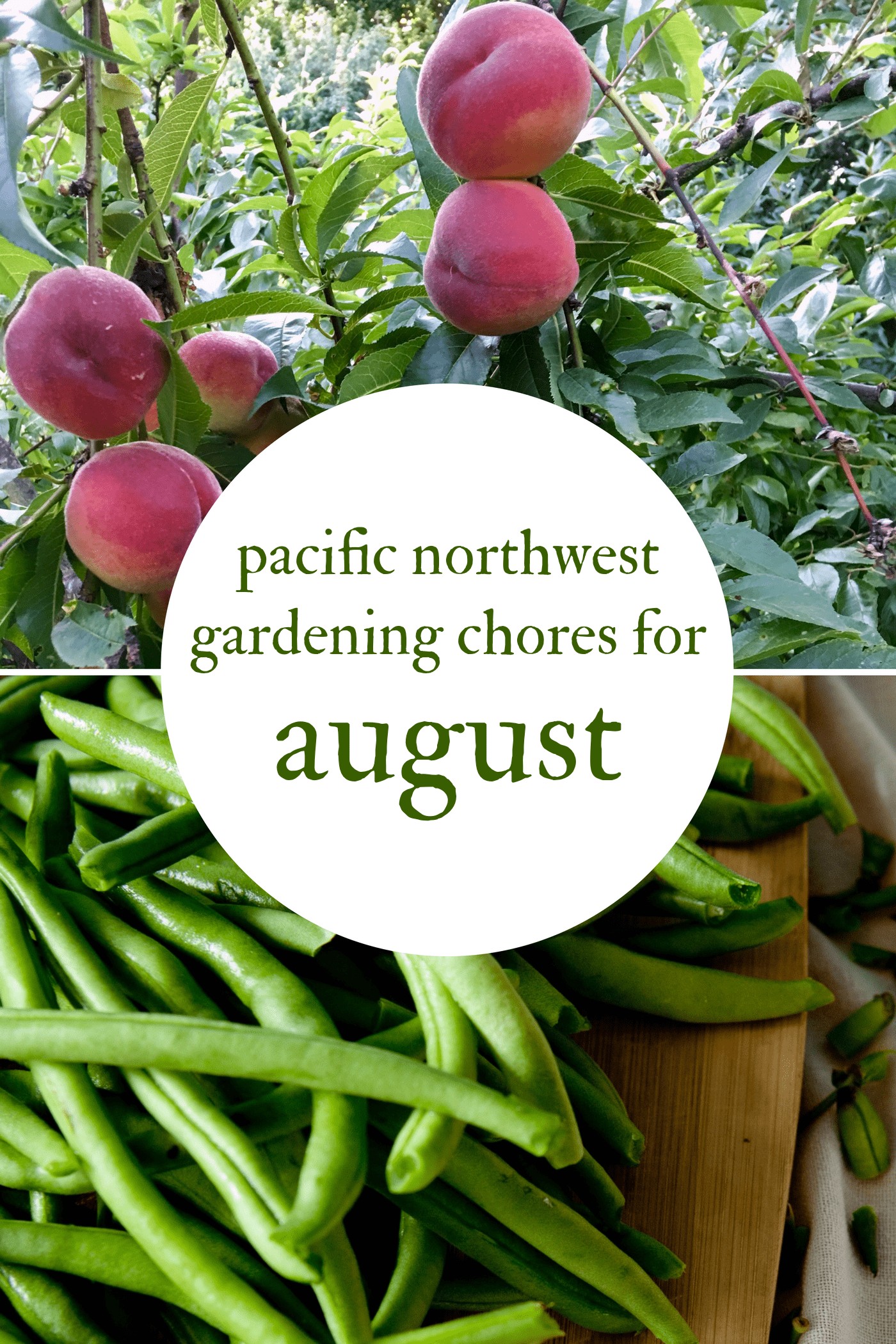
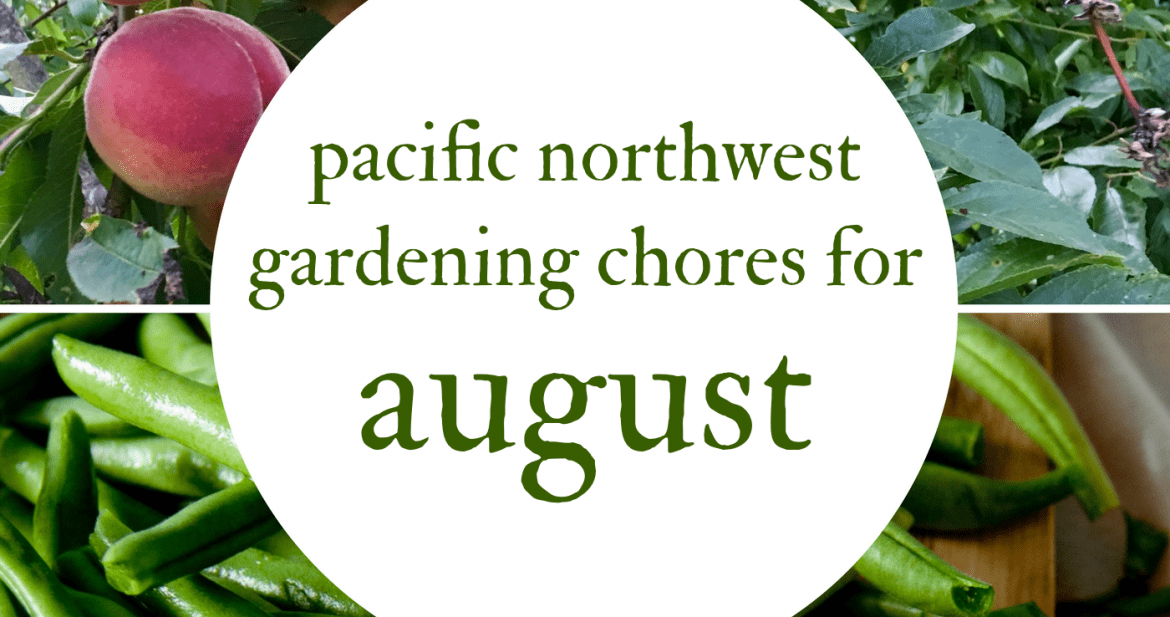
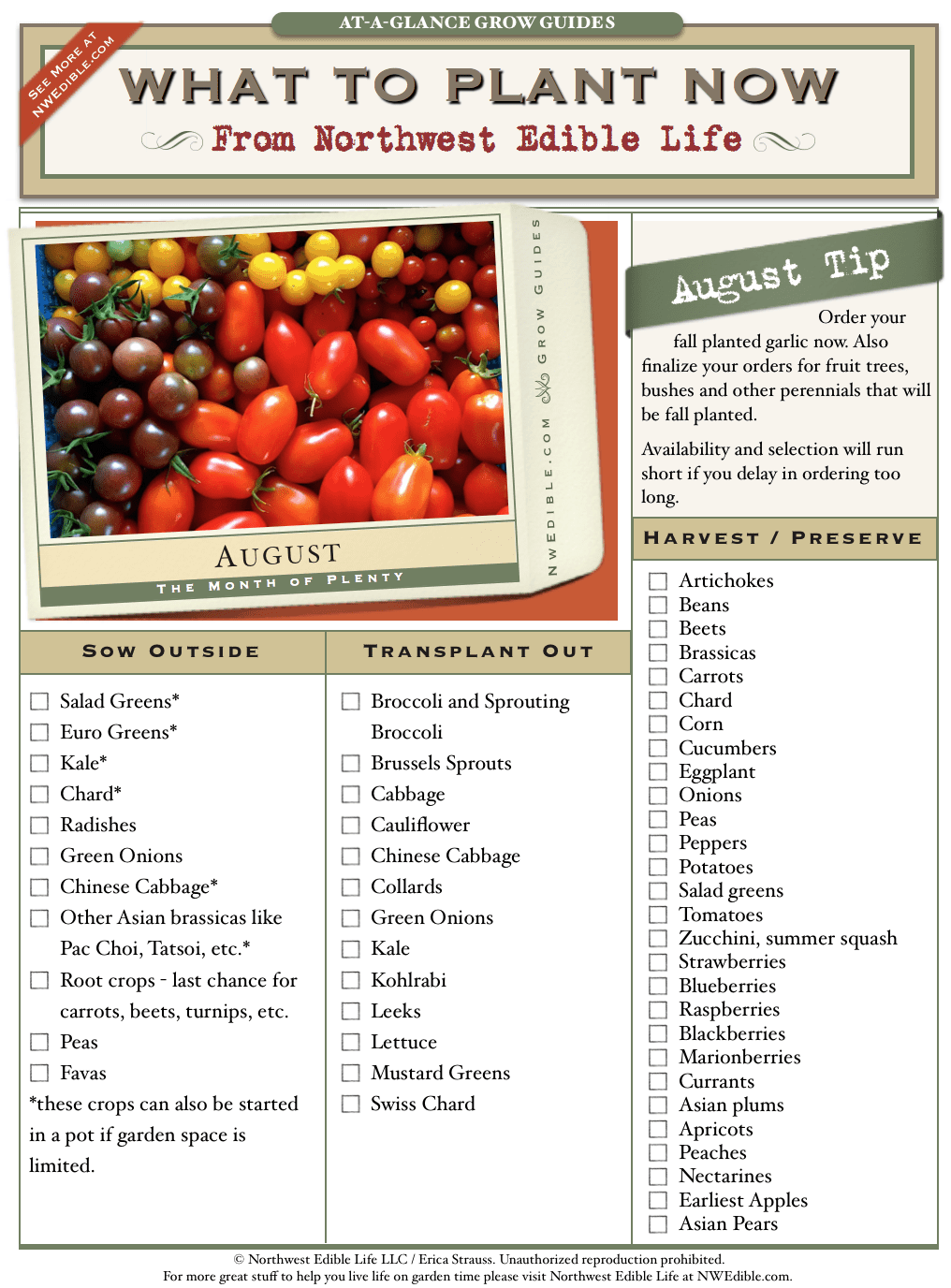
Great guide for us beginners, thank you.
Don’t forget fall peas. It works I swear.
Thank you! Great reminder. Sow end of month for early spring harvest? Or is there a way to get a legit fall crop if you sow, like, right now? Ive only fall sown favas and they mature in spring. Additional info based on your experience really appreciated!
Here’s a quick reference winter crop planting chart that Territorial Seed Company puts out: http://www.territorialseed.com/product/14053. I find it to be incredibly helpful.
Yeah sow this week or next. Keep ’em moist during the heat of August. They should mature end of September if the weather is favorable. The varieties I’ve had luck with are the short vines like Cascadia and Sugar Sprint. I think I got the idea from the Tilth garden guide.
Man, my green beans are already done and I’m sad. 🙁 I probably should have planted another batch. Maybe I’ll start one now.
From where do you order garlic?
Usually just Territorial because I figure I should maximize the flat rate shipping. http://www.territorialseed.com/category/26
Don’t you save your biggest cloves for replanting?
I admit, I’ve only planted garlic a few years now and I’ve always ordered a fresh batch from Territorial too. But I’ve been thinking I’m missing an opportunity to develop a strain that’s best-suited to my garden conditions.
Funny. This post should have a big ‘X’ on it. ‘Cuz I swear it’s treasure.
“I have decided bird netting is spun from filaments of hatred, bound together with evil.” I couldn’t agree more!
This is my first year growing kale so thanks for the reminder that I should get the next round of seeds in. Actually, this is my first year planning to have anything still going after August ends (apart from planting garlic last fall)–I’m excited to extend my garden season!
I have found your blog to be very useful in planning my garden this year. Although I’ve gardened off and on for years, this is the first year I’ve been serious about more than summer eating. Since your climate is very similar to mine (I’m about 90 miles north of you), seeing laid out what works well and when to plant it for the last few years has been great. I found your blog a couple months ago and it has quickly become one of my favorites as I’ve worked my way through your archives. Thanks for being such an enjoyable and informative read.
Well, it’s clear that August is the busiest month of the year in the garden. I love all your detailed guidelines! I wish I knew someone making posts like this re NorCal gardening, is all. But I bet your July guidelines would work pretty well for us in August too. 🙂
Hi! Well I can’t harvest a lot of what you mentioned, things just aren’t there yet, but they are close! I have harvested, Broccoli,lettuce and beets, oh and Rasberry, and blueberry . Sowed more beets, kale, collards , carrots, leattuce. Will be transplanting Broccoli and Cauliflower 🙂 Oh and My eggplants you helped save look much happier!
Ha, ha! “I have decided bird netting is spun from filaments of hatred, bound together with evil.” I hate the stuff, too, but forget about the birds–it’s the squirrels I need to combat. Wrapping our grape arbor with bird netting is the only way I can keep the squirrels from eating the bunches, and they will take every last grape if I let ’em.
CRIKEY!! Erica! That is a big useful list. 😉
K is for Klondike ….
I had to laugh at your weather prediction, I think the last few days have had temps from 55° to 85°!
I’m going to enjoy your blog now that I’ve come across it, I am a mix of vegetable and flower grower and I struggle with the vegetable side of things as the weather here is different to say the least.
Quick question – I’m aiming to plant garlic at the end of this month. Are the dried bulbs one would get at the farmers market the same thing as the ones I should be planting?
I stocked up last weekend because they were a great deal and – well, they’re garlic. Always useful. I asked the farmer about whether or not I could plant the individual cloves and was mortified to learn that the ones in his stall in the Chicago suburbs are actually from California and he has no idea how they’re grown. He said they’re put in the ground as plants – like little baby onions. Umm… I’m pretty sure that’s not right.
So, farmers market garlic – okay to plant or no? Should I be heading to the Farm & Fleet for something that’s completely ‘other’? I’d hate to find out sometime next year that I just buried perfectly good non-growing garlic.
Okay, sorry – it started out as a quick question.
Thanks!
Sorry I just saw this and it’s too late now, but for anyone else who comes across it, YES you can plant out farmers market garlic assuming the farmer knows what the hell he is talking about (yours didn’t I’m afraid) and can tell you what variety it is, if the soil where it’s grown has ever had Garlic or Onion Root Rot (called White Root Rot), and if the heads have been sprayed with anti-sprouting chemicals. If you gardener can answer those questions (variety doesn’t have a right answer, but NO to root rot and NO to spraying) you can plant them in your garden. If the gardener CAN’T then I’d eat them but I wouldn’t plant them. Garlic is not planted like little baby onions by anyone who grows more that 4 cloves worth – it’s planted much like tulip bulbs, and at around the same time of year. More info here: https://nwedible.com/2013/10/how-to-grow-your-own-garlic.html
I’ve let some of my hardneck garlic go to see and re-grow the following year by accident a couple of times, so this year I’ll actually be collecting them up and moving them to a different raised bed to see if they do just as well. They make for great spring garlic. Any suggestions to make this successful? I expect they’ll be smaller than if I just planted cloves like normal.
Can I ask which nursery you prefer? I am in the Bonney Lake area